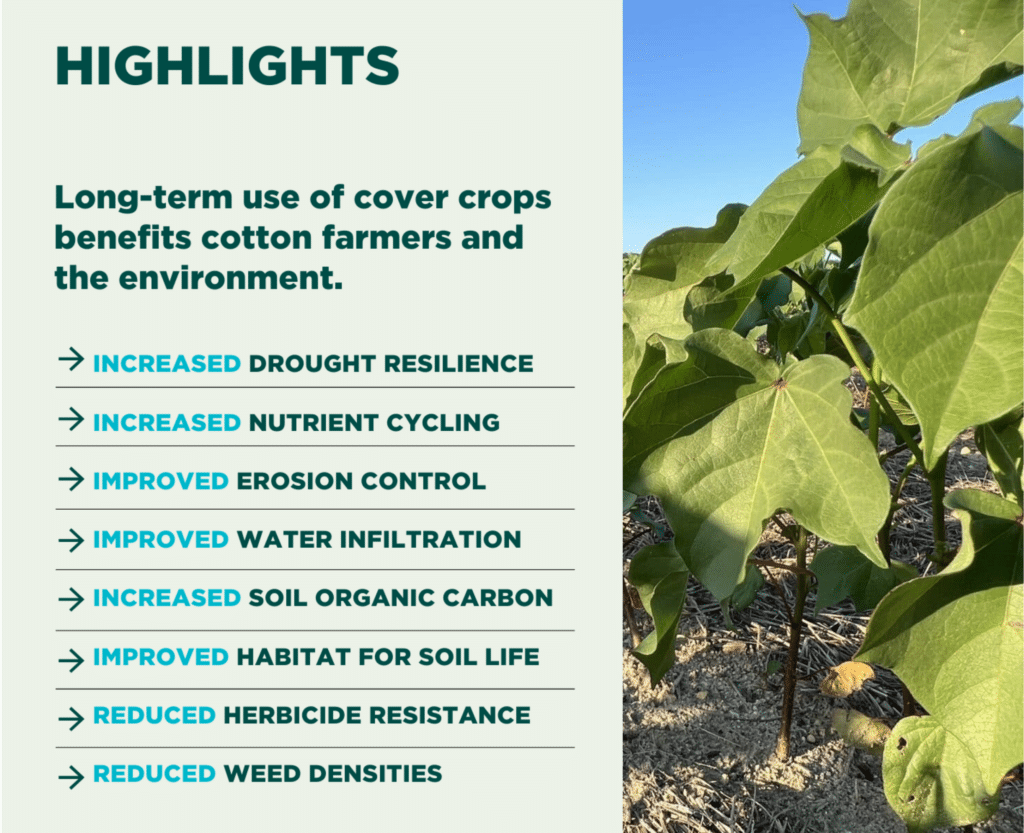Cotton farmers looking to integrate cover crops into their farming practices have a new resource to assist them! That’s thanks to a new factsheet series published by the Soil Health Institute meant to aid farmers in selecting and managing cover crops in cotton production, with weed suppression in mind.
Despite the benefits that cover crops offer, most cotton farmers still aren’t using them. The added management, costs, and sometimes delayed benefits can give growers pause, especially those who farm in water-challenged regions. That’s not even getting into the complexity of choosing the right cover crops for your needs.
That’s why the Soil Health Institute collaborated with Texas A&M AgriLife Research and the Rodale Institute, to publish this factsheet series providing farmers with an overview of everything they need to know about implementing cover crops in cotton production. These factsheets cover topics such as:
- Cover crop management before planting
- Cover crop termination
- Research on cover crop performance throughout the Cotton Belt
- Charts detailing benefits and limitations of popular cover crop species
- Farmer testimonials on cover crop experiences
The factsheets are accompanied by a webinar where Jessica Kelton (a soil health educator with the Soil Health Institute) and Dr. Jodie McVane (a Texas A&M agricultural conservationist) answer farmer’s questions pertaining to:
- Cover crops in dryland cotton production
- Legume versus non-legume cover crop preferences
- General cover crop implementation advice
The factsheets and webinar aim to make all aspects of cover crop implementation more manageable for cotton farmers throughout the country.

Using Cover Crops as a Weed Suppression Tool in Cotton Production
The first factsheet, titled, “Using Cover Crops as a Weed Suppression Tool in Cotton Production,” provides a research-based overview of cover crop benefits, management, termination, selection, and seeding rates. It concludes with general recommendations of how farmers should begin implementing cover crops into their cotton production. “It’s really focused on cover crop management, decisions, and considerations before you even plant.” Kelton says.
Cover Crop Species Comparison for Weed Suppression in Cotton Production
The second factsheet, titled, “Cover Crop Species Comparison for Weed Suppression in Cotton Production,” compiles research from 14 studies on the effects of cover crops in weed suppression. It charts nine of the most popular cover crops based on their type (legume, brassica, etc.), benefits, and potential limitations. Kelton explained this choice, noting, “They all have unique benefits, and can have some limitations that need to be considered prior to planting.”
The studies were conducted across the Cotton Belt, with each study’s location mapped to help farmers identify the information relevant to them.

Use Local Support
Because some cover cropping factors vary from region to region (such as seed availability, planting dates, seeding rates, and field history), getting local input when making your decision can be helpful. The Soil Health Institute recommends reaching out to farmers and agricultural mentors in your area to determine the best cover crop for your growing needs. “Consulting local resources is key to being successful when implementing these cover crops.” McVane says.
The U.S. Regenerative Cotton Fund has a team of 23 technical specialists and farmer-mentors established throughout the Cotton Belt, meant to support and guide farmers who are looking to implement cover crops in their cotton production.
“It can be a challenge to justify an additional offense when cotton prices are so low,” Kelton says, “But when you get the opportunity to talk to growers who have done it, they say, ‘Yes, it’s an expense, but it’s an expense that we will see a return from in a year or two.’”
McVane’s ultimate advice is: “Start small and get good at it. All of you farmers are so creative, you can get good at it. The next thing is to be consistent.”
The factsheets can be found on the Soil Health Institute’s website, and the webinar can be watched on the Soil Health Institute’s YouTube page. To contact one of the US Regenerative Cotton Fund’s specialists or mentors, please reach out to Jessica Kelton at jkelton@soilhealthinstitute.org.
See more GROW on this topic in this news video of a Virginia farmer using cover crops in cotton, and see more on cover crop use for weed suppression on the GROW Cover Crops page.
Text by Amy Sullivan, GROW; Header and feature image by Claudio Rubione, GROW.





























































































